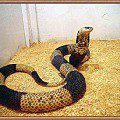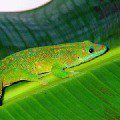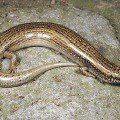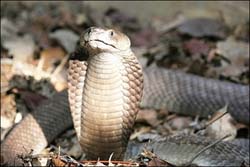
Collared cobra
Collared cobra (Hemachatus haemachatus) is very close to real cobras, but it stands out in a special genus in some important ways. The main difference is that it does not have any teeth on the upper jaw behind the poisonous fangs (real cobras have! – 3 small teeth). Medium-sized, about 1,5 m, the snake has a grayish upper body, along which intermittent oblique stripes are scattered. Often there are very dark snakes. Unlike real cobras, the collared cobra does not lay eggs, but gives birth to live cubs.
Contents
Description
 Regardless of the name, the collared cobra remains a very dangerous venomous snake. Its average length is about one and a half meters. The upper body has a grayish tint, along which oblique transverse intermittent stripes pass. However, sometimes there are quite dark individuals. In any case, the head of this cobra is always black, the neck is also black from below. The head itself is short and pointed, with large black eyes. Further along the belly are several black and white wide transverse stripes, which are clearly visible in those moments when the cobra assumes a threatening posture. Like a real cobra, it, spreading the cervical ribs to the sides, expands the neck. However, its hood is narrower than that of a real cobra.
Regardless of the name, the collared cobra remains a very dangerous venomous snake. Its average length is about one and a half meters. The upper body has a grayish tint, along which oblique transverse intermittent stripes pass. However, sometimes there are quite dark individuals. In any case, the head of this cobra is always black, the neck is also black from below. The head itself is short and pointed, with large black eyes. Further along the belly are several black and white wide transverse stripes, which are clearly visible in those moments when the cobra assumes a threatening posture. Like a real cobra, it, spreading the cervical ribs to the sides, expands the neck. However, its hood is narrower than that of a real cobra.
In danger, this cobra inflates the hood, raising the upper part of the body.
It belongs to the so-called “spitting” cobras – because of its ability to throw poison at a distance of up to 2 meters. By sharply reducing the temporal muscles, the snake creates pressure in the venom gland up to one and a half atmospheres, and the poison is sprayed out in two thin streams, merging into one at a distance of half a meter. Moreover, they usually aim at the eyes, sometimes, however, being deceived by shiny buttons on their clothes. But their accuracy does not suffer from this – from a distance of about 60 cm, any individual of this species can hit its target with XNUMX% accuracy. And the maximum range of hit is about two meters. Moreover, the poison is not sprayed pointwise, but according to a certain geometric sequence, which allows you to hit the victim as accurately as possible.
The collared cobra is very close to real cobras, but it was not accidentally singled out as a separate genus. First of all, because behind the poisonous fangs on the upper jaw they have no teeth at all (for example, a real cobra has three small teeth). The fangs themselves are directed forward.
Cobras tense their head and neck muscles in the instant before spitting. They then squirt the venom forward while the muscles of the head and neck perform rapid head wobbles that disperse the venom. This is how a complex pattern of venom droplets is formed, increasing the chance of the venom getting into the victim’s eyes. Collared cobras do not even need to aim directly at the eyes. They just need to choose the right direction.
Their venom is strong enough to cause blindness if it enters the eyes of mammals, including humans. This reaction is probably more for defense than for prey destruction, although they also use poison when obtaining food.
Its venom has a neurotoxic effect, so its attack causes terrible pain and can lead to blindness if it hits the eyes. In case of a bite, the area around this place turns red and swells, hematomas and necrosis are possible.
In addition to active defense, the collared cobra can also use passive techniques, as well as some already-shaped snakes. She pretends to be dead, rolling onto her back. At the same time, it relaxes the muscles so much that it becomes soft, opens the mouth and throws out the tongue.
Inhabitation
The collared cobra lives in South Africa. It is predominantly found in the South Eastern and Southern Capes, Lesotho, Orange Province, KwaZulu-Natal, Transkei, South Eastern Transvaal and Swaziland. Sometimes it is possible to meet this species on the borders of Mozambique and Zimbabwe. For habitat, she chooses grassy meadows, although she can adapt to living at sea level and even above it. She can be found basking in the sun, although she still prefers a nocturnal lifestyle.
Reproduction
Unlike other cobras, the collared cobra is not an egg-laying snake, but a viviparous one. Under natural conditions, cobras are seasonal snakes: in July, the female lays 9-19 eggs, of which young animals appear in late August – early September. The average brood size is 20 to 30 individuals. Newborn cobras are already quite large, the average size of the cub is 15-18 cm in length. Within an hour after birth, young individuals change their skin. The coloration of a newborn collared cobra is the same as that of an adult, including distinct stripes around the necks. In the same way, they are already capable of spitting poison from birth.
Classification
Kingdom: Animalia (animals)
Type: Chordata
Class: Reptilia (reptiles)
Order: Squamata (scaly)
Suborder: Serpentes (snakes)
Family: Elipidae (aspididae)
Genus: Hemachatus (collared cobras)
Species: Hemachatus haemachatus (collared cobra)
Food
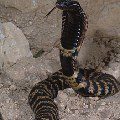 The main diet of the collared cobra in nature is mainly toads, but if there are few of them, the cobra preys on small mammals, birds, insects, frogs and even other reptiles. Like other asps, cobras willingly eat snakes, including poisonous ones. She obtains food with the help of poisonous spitting, spraying poison with amazing accuracy at a distance of up to 2 meters, and aims exclusively at the eyes of the victim.
The main diet of the collared cobra in nature is mainly toads, but if there are few of them, the cobra preys on small mammals, birds, insects, frogs and even other reptiles. Like other asps, cobras willingly eat snakes, including poisonous ones. She obtains food with the help of poisonous spitting, spraying poison with amazing accuracy at a distance of up to 2 meters, and aims exclusively at the eyes of the victim.
In captivity, to maintain the health of your pet, you will need to feed food that is closest to what snakes eat in the wild. Collared cobras will not last long on insects alone, so you can’t do without live food. Toads, frogs, chickens and other chicks, rabbits, mice, rats, etc. are well suited as food for them. Additional insect species that are used as food for the collared cobra are small reptiles, giant worms, grasshoppers, locusts, silkworms, and others. Many cobras prefer toads and frogs as their staple food, while other foods can be used to diversify their diet.
Live food should be fresh and well-groomed, because the quality of digestion of food and the health of the snake depend on it.
Additionally
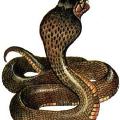 Due to the persistent fixation of morphological features that provide the “spitting” mechanism, all spitting cobras develop a characteristic behavior that precedes “spitting”: raising the body in a classical stance, raising only the head, slightly opening the mouth, the act of throwing, etc. The cobra always threatens before an attack, this is what the ideas of Indian fakirs are based on. The standard set of gestures includes a menacing stance, hood puffing, and a vicious hiss. If this does not work, a poison shot follows. But it is best not to bring the collared cobra to a bite or spit, leaving its path in time.
Due to the persistent fixation of morphological features that provide the “spitting” mechanism, all spitting cobras develop a characteristic behavior that precedes “spitting”: raising the body in a classical stance, raising only the head, slightly opening the mouth, the act of throwing, etc. The cobra always threatens before an attack, this is what the ideas of Indian fakirs are based on. The standard set of gestures includes a menacing stance, hood puffing, and a vicious hiss. If this does not work, a poison shot follows. But it is best not to bring the collared cobra to a bite or spit, leaving its path in time.
Prevention of bites comes down to one main rule – do not stick to cobras. If you wander around their habitats, do not hide – the snake, sensing the approach of a person, will try to hide itself. Of course, if you find yourself near its nest, the snake will fight to the last, but usually the cobra will try to avoid the attack, getting by with a threat display.
Spitting cobras are twice as dangerous as ordinary venomous snakes – they can not only bite, but also spray poison into the eyes of the victim. Contact with poison on the mucous membrane of the eye is very painful and is fraught with the development of conjunctivitis, swelling of the eyelids and headache for several hours. If not treated promptly, corneal ulceration, uveitis, and permanent blindness occur.
Despite the fact that the bite of a cobra is one of the most painless among all snake bites (it is not for nothing that its poison is part of a powerful painkiller), when biting a collared cobra, quite severe pain, bleeding and local swelling are noted. Later, general symptoms of poisoning occur: drowsiness, nausea, occasionally vomiting, paresthesia and muscle weakness, however, a pronounced neurological syndrome is described less frequently than with real cobra bites. Breathing becomes shallow and rare, blood pressure drops, and a picture of heart failure develops. In severe cases, the victim dies after a couple of hours from paralysis of the respiratory center. Most deaths occur on the first day after the bite.
The most effective treatment for a bite is the immediate administration of Anticobra serum, subcutaneously or intramuscularly, and if symptoms develop rapidly, intravenously. In extreme cases, a polyvalent serum against neurotoxic poisons of viper, efa and cobra is suitable. In this case, it is not necessary to inject serum into the bite site, since it gives a general antitoxic effect.
In the next 5 minutes after the bite, you need to suck out the contents of the wound with your mouth or a blood-suction jar. After suction, the wound must be treated with antiseptics, and then a sterile, non-compressive bandage should be applied.
In case of contact with the eyes, they should be rinsed immediately with water, then as soon as possible with saline, and Neo-Cortef 1.5% ointment should be applied three times a day for several days. With immediate eye treatment, serum rinsing is not necessary.
Sources of
http://www.zmeuga.ru
http://dic.academic.ru
http://www.rentokileesti.ee/ru
http://www.floranimal.ru
http://www.i-nature.ru
http://www.zapishi.net
http://www.infozoo.ru
http://big-snake.narod.ru/
http://myreptile.ru/
Other names
In Russian-language sources, the snake of the species Hemachatus haemachatus is called “Collared Cobra”, in English – “Ringhal”. In the homeland of the snake, in South Africa, it was called “spui-slang” – because of its tendency to “spit” poison. In some sources, the name “spitting cobra” (English spitting cobra) is even found, but this is wrong, because in addition to the collared cobra (Hemachatus haemachatus), other types of cobras can also spray poison, for example, a large brown spitting cobra (Naja ashei), Indian spitting cobra (Naja naja sputatrix) or black-necked cobra (Naja nigricollis).
Habitat
The collared cobra lives in South Africa, but most often it was found in the Southern and Southeastern Cape Province, Orange Province, Lesotho, KwaZulu-Natal, Transkei, Southeastern Transvaal and Swaziland. Sometimes it is possible to see this type of snake on the borders of Mozambique and Zimbabwe. For habitat, the collared cobra chooses grassy meadows, although it can adapt to living at sea level and even above it. She can be found basking in the sun, although she still prefers a nocturnal lifestyle.
Content
Keeping a poisonous snake at home, especially a spitting cobra, is a very dangerous and difficult task. We highly recommend not to have such a pet in a home terrarium, because even experienced herpetologists usually do not risk having poisonous snakes at home. Special conditions are needed for their maintenance: a separate empty room without gaps, a solid terrarium with built-in equipment (UV lamps, thermometers, hygrometers, etc.), special tools (hooks, tongs, fixing sticks, tweezers), a mask for protection eye, plexiglass shields and gloves. If you still decide to get a collared cobra, you should always have the AntiCobra serum on hand, or, at worst, a polyvalent serum against the neurotoxic poisons of viper, efa and cobra.



